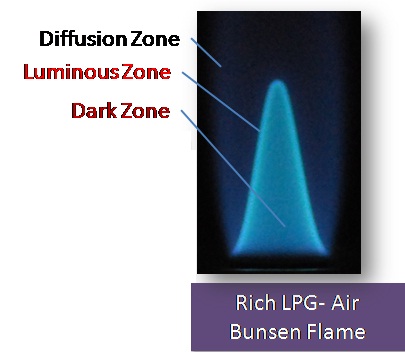1-D Premixed Flame

- Decomposition of fuel takes place, leading to intermediate radical formation.
- Certain chemical reactions take place in this zone.
- Reaction zone is very thin as compared to the preheat zone.
- Temperature gradient and concentration gradient are high.
- Diffusion of heat and radicals from this zone to preheat zone sustains combustion.
- Negligible heat release in this zone.
 Preheat Zone: Negligibly small heat release.
Preheat Zone: Negligibly small heat release.
Reaction Zone: Most of the chemical energy is released in the form of heat.
Recombination Zone: CO2 and H2O are formed.

-
Luminous Zone: Portion of flame in which temperature is high and has several radicals to emit radiation.
- Highest temperature prevails in this zone.
- Color of luminous zone depends on the fuel-air ratio.
- Fuel lean mixture: blue colored flame due to excited CH radical.
- Fuel rich mixture: green colored flame due to excitation of C2 molecule.
- Highly fuel rich mixture: yellow colored flame due to soot formation.
- Observed especially in rich flames.
 Hydrocarbon flames – characterized by the emitted visible radiation.
Hydrocarbon flames – characterized by the emitted visible radiation.
Dark zone: unburnt gases are heated to the critical temperature.
Luminous zone: region where much of the chemical reactions take place.
Diffusion Zone: outer cone above luminous zone.
Characterization of Premixed Flame

-
Importance of burning velocity
- Premixed flame can be characterized by laminar burning velocity.
- Laminar burning velocity influences the flame shape.
- Laminar burning velocity dictates the stability characteristics of the flame.
- Laminar burning velocity dictates flame quenching.
Burning Velocity Measurement Methods

Stationary Flame Method (Bunsen Burner)



First laboratory premixed flame burner : invented by Robert Bunsen in 1855
How to get a parabolic velocity profile?
By providing sufficient tube length to ensure fully developed flow.
Stationary Flame Method (Bunsen Flame)
Angle Method

- Uniform velocity profile has to be maintained at the tube exit.
- Nozzle is employed to maintain uniform velocity profile.
- Infinitely thin perfectly conical flame front is established.
- For flame to be stationary, the local burning velocity must be equal to the local flow velocity.
-
Area Method
- The gas burns at the exit of the tube and a conical flame with a tip and base is established.
- For flame to be stationary, the local burning velocity must be equal to the local flow velocity.
- Flame shape will be influenced by the exit velocity profile and heat loss to the tube wall.
- Lengthy tube ensures fully developed flow.
- For a stationary flame, mass balance provides expression for SL
 Vu: average flow velocity in tube
Vu: average flow velocity in tube
At: tube cross sectional area
AF: conical surface area of flame
This method is known as area method.

-
Disadvantages:
- Heat loss to the wall cannot be avoided completely.
- Burning velocity does not remain constant along its surface.
- Flame stabilization for large diameter is difficult due to flash back.
Procedure for Area Method

By carrying out a mass balance across the flame,
 Vu - average flow velocity of the unburned fuel-air mixture
Vu - average flow velocity of the unburned fuel-air mixture
At - cross-sectional area of the tube
AF - conical surface area of the flame
flame surface area,











